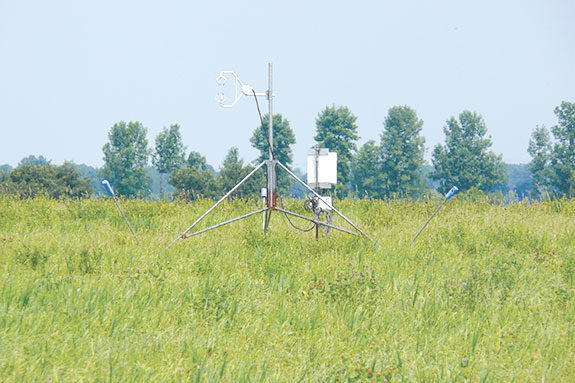The study is led by Claudia Wagner-Riddle, professor at the School of Environmental Sciences at the University of Guelph, and includes researchers from several disciplines (engineering; soil, plant and animal science) and collaborators spreading across Canada and even stretching into the U.S. Funding for the project is being provided by Agriculture and Agri-Food Canada, under the Agricultural Greenhouse Gases Program, and Dairy Farmers of Canada.
 Greenhouse gases have always naturally been present in the atmosphere, allowing the planet to maintain a temperature able to sustain life.
Greenhouse gases have always naturally been present in the atmosphere, allowing the planet to maintain a temperature able to sustain life.
This is known as the “greenhouse effect.” However, human activities have been increasing the levels of greenhouse gases in the atmosphere and have enhanced this effect.
Increased warming of the atmosphere could cause changes to the climate and weather patterns over time, including increased incidence of heat waves, warmer overall average temperature, changes in water availability, extreme storm events, drought and pests, which will impact agriculture production.
The potential effects on Canadian agriculture include: increased heat stress in livestock, increased pests (in volume and number of pest species), modified areas in which specific crops can be grown due to climate changes and financial challenges for rural areas involved in extreme weather events.
Another possible effect to the agriculture industry resulting from increasing atmospheric greenhouse gas concentrations is changes in consumer demand.
Consumers are becoming increasingly conscious about the environment and greenhouse gases and are looking for more environmentally friendly products. As this trend continues, the agriculture industry is stepping up its efforts to produce products in a more sustainable way.
Agriculture is not usually the first culprit thought of when it comes to greenhouse gases, but agriculture contributes approximately 12 percent of the world’s greenhouse gases. The dairy industry alone is the cause of 4 percent of global emissions.
While agricultural and global emissions overall have been increasing over time, the Canadian dairy sector has actually been decreasing its total greenhouse gas production.
This has been mainly due to advancements in the past few decades that have allowed for increased efficiency and production.
Progress in genetics, management and technology has increased milk production and efficiency per cow, and has caused a large reduction in the dairy cow population over the last 50 years.
While a high-producing cow today has higher emissions compared with a cow from several decades ago, the lowered dairy cow population means that overall, total greenhouse gas production from the dairy sector has been decreased.
Therefore, while total agricultural and global greenhouse gas emissions have increased over time, emissions from the dairy sector have been decreasing.
However, the rate of decline is beginning to slow. Genetic progress is slowing, and as a result, so has the ability of dairy farms to reduce greenhouse gas emissions through improvements in efficiency.
Farmers will need to make active management changes if they want to further decrease emissions, and research is needed to identify practical methods to do this.
The project is focusing on three main areas for greenhouse gas mitigation: feeding strategies, manure management and cropping systems, as well as incorporating new knowledge into mathematical models to estimate emissions.
 The portion of the study looking at feeding strategies includes two commercial dairy operations in southern Ontario.
The portion of the study looking at feeding strategies includes two commercial dairy operations in southern Ontario.
Greenhouse gases and ammonia emissions are being measured from these farms, and diet and feedstuffs information is being collected and analyzed. An engineering master’s student at the University of Guelph has been monitoring barn air quality from one of these farms since April.
Air is continuously sampled from the barn and analyzed for carbon dioxide, methane and nitrous oxide concentrations to determine air quality and greenhouse gas output.
Information from these farms is also being sent to a modelling team at the University of California – Davis, where researchers are working on developing a model for predicting carbon and nitrogen concentrations in different organic compounds in urine and manure from dairy cows.
Manure management is being studied at multiple locations in Canada, one of which is a farm in southern Ontario that is installing an anaerobic digester.
Researchers have already measured emissions from the manure lagoon in 2010 and 2011, and once the digester is operational, they will be comparing this to emissions measured from the storage of post-digestion materials.
At another location, solid-liquid separation and reduced methane production through manure storage emptying are being studied.
 Development of mitigation strategies in cropping systems is also taking place at multiple institutions.
Development of mitigation strategies in cropping systems is also taking place at multiple institutions.
Direct and indirect (i.e. – leaching) emissions from soil are being studied on both small plots, as well as four two-hectare plots. Some of the research includes measuring nitrogen-leaching at one field site, as well as comparing the emissions from two fields with different soil textures – sand versus clay – at another site.
The majority of work being done, and occurring on multiple sites, is measuring and comparing emissions between different types of manure/fertiliser application methods, and the time of year that application is being done (spring versus fall applications).
On all field sites, ammonia emissions are measured for two weeks after manure application, and nitrous oxide emissions are measured using static chambers throughout the year. Soil moisture and temperature measurements, as well as soil samples, are also taken for analysis.
The crops used for the purposes of this study are mostly corn, with some measurements also being taken on grass hayfields.
The project is still in the data collection phase, and researchers will be continuing their work until the project wraps up in 2015. Results from all of the component studies will be combined to determine which practices produce the lowest greenhouse gas emissions.
This will allow for the identification of best management practices for the reduction and mitigation of greenhouse gases that can be recommended to Canadian dairy producers for implementation on their farms. PD
Jaclyn Kaufman is a student at the University of Guelph. She worked in the summer of 2012 as part of the Undergraduate Student Experiential Learning Program with Tom Wright, OMAFRA, and Claudia Wagner-Riddle, University of Guelph, on this project. For more information, click here to contact Wright or click here to contact Wagner-Riddle.
PHOTOS
TOP RIGHT: Emissions equipment set up in a hayfield.
MIDDLE RIGHT: A researcher samples emissions flux in corn plots.
MIDDLE RIGHT: An anaerobic digester, which will be part of the manure management study, is nearly operational on a southern Ontario farm.
BOTTOM RIGHT: Air quality is also being monitored on southern Ontario farms. Photos courtesy of Tom Wright.
 |
|
|
Jaclyn Kaufman |








